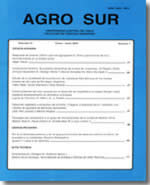Phenotypic plasticity of Holcus lanatus L. accessions collected from pastures with contrasting levels of soil available phosphorous
Main Article Content
Abstract
Holcus lanatus L. is a naturalized perennial grass that colonize a wide range of soil conditions of the Humid Dominion of Chile. The hypothesis was that H. lanatus has grounded his success as a colonizer plant species in environments with contrasting soil available phosphorus (P-Olsen) through its phenotypic plasticity. The objective was to determine the response in growth and development of H. lanatus accessions, collected from soils with contrasting available phosphorus levels, to increasing levels of phosphorous fertilization. The experiment was conducted in a glasshouse at the Universidad Austral de Chile. Three H. lanatus accessions collected from soils with high levels of phosphorus (1A, 2A and 3A) and three collected from soils with low phosphorus levels (1B, 2B and 3B) were transplanted to pots and propagated by tillers. The experiment was established in 2 kg pot soil with a low phosphorus level (Valdivia Soil Series). Three independent tillers of each accession were established in six different phosphorus soil levels (0, 14, 28, 57, 114 and 228 mg P/kg dry soil). A nutritive non-phosphorus solution was added to each pot during the entire experiment. Three harvests were conducted leaving a 3 cm tiller residual. At plant level horizontal growth, growth habit, undisturbed plant height, tiller number per pot, dry matter, and leaf phosphorus concentration were measured. Leaf appearance rate, tiller length, lamina width, lamina length, sheath dry matter, and lamina dry matter were measured at tiller level. A complete block design with a factorial arrangement of the 36 treatments and 4 blocks was utilised. The main results suggest that the phosphorus level applied modified the characteristics of the plants, although it did not change the morphology of the tillers with the exception of the sheath dry matter and the rate of leaf appearance. Even when there was a significant interaction between the accessions and the phosphorus levels in the dry matter production of the first harvest, the six accessions used in this experiment did not differ in their ability to grow in soils with different levels of phosphorus. These results suggest that H. lanatus has developed plasticity to grow in soils with contrasting phosphorus levels.

